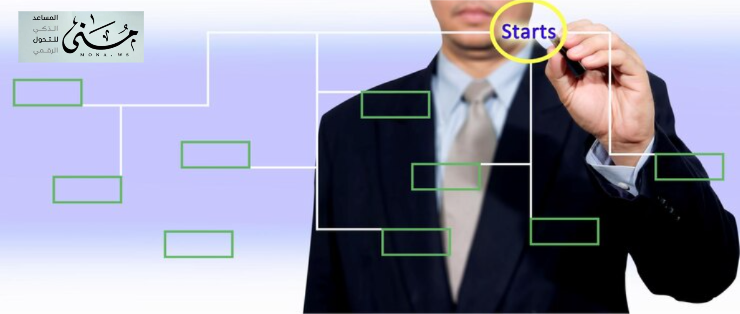Managing the organizational structure is the backbone on which institutions rely to ensure coordination of efforts and achievement of goals. With the complexity of today's work environments, it has become necessary to organize relations between departments and distribute tasks in a clear and effective manner. Both the organizational structure and the job description play an important role in drawing the work map within the institution.
TContinue reading the article to learn more information.
What is the concept of organizational structure?
The organizational structure is defined as the system that defines the administrative relationships between departments and employees within the organization, which enhances coordination and efficiency. Managing the organizational structure and job description effectively contributes to organizing operations, enhancing internal communication, and motivating employees to perform more efficiently.
In any successful organization, organizational structure and job descriptions are essential tools that help achieve harmony between individuals and processes.
A job description is a document that details the responsibilities of each position within an organization, including daily tasks, required qualifications, and necessary skills. A job description is an important tool that ensures clarity of roles among employees, which reduces overlap or conflicts in the work environment.
The importance of organizational structure and job description
Efficiency and transparency are among the most important factors that contribute to the success of any organization, which is why the organizational structure and job description play a crucial role in achieving these goals. By understanding this importance, organizations can enhance their overall performance and overcome challenges.
The organizational structure ensures that tasks and responsibilities are distributed in a thoughtful manner that reduces duplication and time wastage, while the job description helps clearly define the scope of work for each employee.
Moreover, organizational structures define communication channels between departments and individuals, which facilitates the flow of information and decision-making, and with clarity of roles, employees feel confident and stable, which motivates them to perform better.
Types of organizational structures
Choosing the appropriate organizational structure represents a major challenge for organizations, as it depends on the nature of the work, the size of the organization, and its strategic goals. There are several types of organizational structures, each with its advantages and disadvantages, which are:
Functional structure
This type is based on dividing the organization based on specializations, which allows for high efficiency in distributing resources. However, it may lead to poor communication between departments.
Sectoral structure
Focuses on segmenting the organization by products or customers, which helps focus efforts on each segment, but may require additional resources.
Geographic structure
It is ideal for companies with large geographical expansion, where operations are divided by regions, and provides a quick response to local needs, but may require standardization of policies between branches.
Network structure
Suitable for organizations that rely on independent work teams. It is flexible and creative, but requires advanced technical systems to manage teams effectively.
Managing organizational structure and job descriptions is one of the most important factors for the success of organizations. Using modern systems such as DocSuite, organizational efficiency can be improved, transparency enhanced, and the ability to adapt to the challenges of the era increased. Organizations that rely on these digital solutions are always at the forefront.
The most prominent modern systems for managing the organizational structure
As work environments become increasingly complex, it has become necessary to rely on modern technical systems to simplify the management of organizational structure and job descriptions. These systems help organizations achieve efficiency, enhance transparency, and increase the ability to adapt to changes. They are:
DocSuite
An integrated system that uses artificial intelligence technologies to analyze data and improve efficiency, contributes to the flexible design of organizational structures and ensures data security through cybersecurity technologies.
Workday
Provides dynamic tools for managing organizational structures, helping organizations adapt to constant changes.
SAP SuccessFactors
Focuses on human capital management, and provides solutions for developing job descriptions in line with the organization's goals.
Oracle HCM Cloud
It provides comprehensive tools for analyzing organizational structure and improving management performance, making it suitable for large companies.
The role of digital transformation in managing the organizational structure
In the age of digital transformation, job structure and job descriptions are no longer just static documents that define roles and responsibilities, but rather dynamic tools that adapt to rapid changes in the market. Digital transformation is reshaping the way organizations are managed and enhancing efficiency and sustainability.
Digital technologies make it possible to design and modify organizational structures and job descriptions flexibly and efficiently. Systems like DocSuite provide interactive dashboards that simplify the planning and data analysis process.
In addition, these systems contribute to improving transparency, reducing errors, and enhancing the employee experience through tools that clarify career paths and promotion opportunities, as well as reducing paper consumption and supporting the Kingdom’s Vision 2030 to achieve environmental sustainability.
Key statistics related to organizational structure and job description
Statistics reflect the role of structure and job description in improving the performance of institutions and the extent of their impact on productivity and employee satisfaction. Relying on this data helps institutions make informed decisions and develop effective strategies. The most important global and local statistics are the following:
- According to a report issued byHarvard Business Review, Companies that adopt flexible organizational structures achieve up to 25% more productivity than companies with rigid structures.
- 73% of organizations that restructure their organization periodically improve their financial and operational performance within the first two years.
- A study conducted by revealedGallup found that 70% of employees who work in an environment with a clear job description feel satisfied with their jobs, compared to only 45% in organizations that lack role clarity.
- Organizations that provide accurate job descriptions see a 30% reduction in employee turnover.
- A report fromDeloitte found that 60% of companies that adopted modern management techniques such as DocSuite achieved an improvement in decision-making speed and a 40% reduction in management errors.
- 85% of large and medium-sized companies that adopt digital systems to manage organizational structures and job descriptions reported savings in operational costs of up to 20%.
- 50% of SMEs say the biggest challenge in managing organizational structure is employee resistance to change, according to a PwC report.
- 30% of organizations in the Middle East suffer from the absence of clear job descriptions, leading to role conflict and decreased operational efficiency.
These figures provide a comprehensive view of the importance of structure and job description in achieving organizational excellence, and emphasize the need to adopt modern technologies such as digital management systems to ensure efficiency and improve performance.
Challenges Facing Organizational Structure Management
Despite the importance of the organizational structure and job description in enhancing institutional efficiency, many organizations face challenges that affect their ability to organize these elements effectively. The most important challenges include the following:
Resistance to change
Many employees and departments resist changes in structure and job descriptions, especially when switching to digital models or automating procedures.
Poor alignment with strategic objectives
The organizational structure may be inconsistent with the overall goals of the organization, leading to conflicting priorities and difficulty achieving desired results.
Complexity of operations
Large organizations have difficulty coordinating complex organizational structures that include multiple departments and geographic locations.
Lack of resources and technology
Limited budgets or lack of knowledge of new technologies may be a barrier to improving organizational structure and job descriptions.
Poor internal communication
The absence of clear channels of communication between departments and employees can lead to role overlap and poor productivity.
Strategies for improving organizational structure and job descriptions
Organizations need to adopt effective strategies to improve organizational structures and job descriptions, ensuring their alignment with strategic objectives and achieving efficiency. The most important strategies are the following:
Digital transformation
Using advanced systems such as DocSuite to analyze data and organize operations in a flexible and dynamic manner.
Continuous training
Providing training courses for employees and managers on the importance of organizational structure and job description, and how to benefit from them to achieve efficiency.
Involve employees in planning
Employee participation in the design of organizational structures and job descriptions enhances acceptance and reduces resistance to change.
Analyze data periodically
Review the performance of the structure and job description on a regular basis to ensure that they achieve organizational objectives.
Enhance internal communication
Establish effective communication channels that ensure information flows easily between different departments.
The relationship between organizational culture and organizational structure
Organizational culture reflects the values and principles that characterize the organization, and directly affects the design of the structure and job description. Understanding this relationship helps build an integrated and sustainable work environment.
Organizational culture determines how individuals work within an organization, and influences the way tasks and responsibilities are distributed. For example, in organizations that adopt a culture of innovation, flexible organizational structures are designed that allow employees to work independently and participate in decision-making.
In organizations that focus on operational efficiency, hierarchical organizational structures are adopted that promote discipline and clearly define roles.
Hence, the organizational culture must be consistent with the structure and job description to achieve optimal performance.
When an organizational structure is carefully designed and provides clarity in roles and responsibilities, employees feel stable and confident, which enhances their job satisfaction. Additionally, a clear job description reduces conflict within the team and ensures that each employee knows exactly what is expected of them.
 إلإدارة الفعالة لـ الهيكل التنظيمي تحقق النجاح المؤسسي
إلإدارة الفعالة لـ الهيكل التنظيمي تحقق النجاح المؤسسي











Comments
Add New Comment